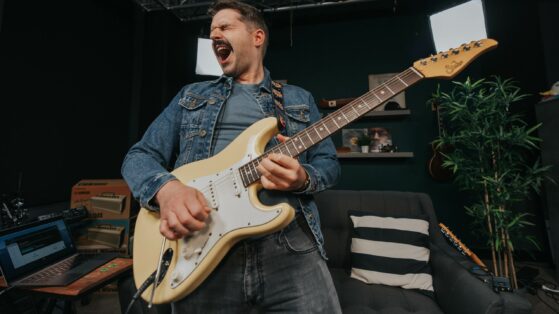The Secret to Perfect Guitar Sustain and How to Achieve It
Guitar sustain—the magical, lingering note that seems to hang in the air like an ethereal voice—is one of the most sought-after qualities by guitarists across all genres. Whether you’re blazing through a powerful solo or weaving a soft, expressive melody, sustain has the unique ability to add emotional depth and musical richness. It’s the difference between a note that fades quickly and one that sings with soul. Yet, despite its importance, many guitarists struggle to unlock the secret to perfect guitar sustain. What exactly creates that rich, long-lasting tone, and how can you achieve it consistently in your playing? In this comprehensive guide, we’ll dive deep into the science, setup, and technique behind sustain—and reveal the practical steps you can take to make your guitar sing like never before.

Understanding Guitar Sustain | What Is It Really?
Before diving into how to achieve sustain, it’s essential to understand what sustain actually means. Sustain is the duration a note rings out clearly after being plucked or strummed before it fades away into silence. In other words, it’s how long your guitar can hold a note with audible clarity and fullness.
Many factors influence sustain—some are rooted in the guitar itself, others in playing technique, and some in the equipment you use. When combined thoughtfully, these elements can produce sustain that feels like your notes are singing on forever.

The Role of Your Guitar in Sustain
Body Construction and Wood Type
One of the biggest contributors to sustain is your guitar’s physical makeup. The type of wood used in the body and neck, along with the construction style, plays a vital role in how vibrations transfer and persist.
Solid-body guitars, especially those made from dense woods like mahogany or maple, tend to have better sustain due to their ability to efficiently transfer string vibrations without absorbing too much energy.
On the other hand, hollow-body or semi-hollow guitars often have less sustain because their hollow chambers dissipate vibrations faster.
Neck and Fretboard Materials
The neck wood and fretboard material also affect sustain. Harder woods such as rosewood or ebony generally offer more sustain by reflecting vibration energy better than softer woods.
Bridge and Nut Quality
The hardware components that anchor the strings—like the bridge and nut—should be solid and properly installed. A poorly seated bridge or a nut that allows excessive string movement can kill sustain by dissipating energy prematurely.

String Choice and Its Impact on Sustain
Transitioning from your guitar’s build to the strings themselves, it’s worth noting that string gauge and material have a significant impact on sustain.
Heavier gauge strings tend to sustain longer because their mass carries more vibrational energy.
Materials like nickel-plated steel or pure nickel often produce warmer sustain, while stainless steel strings offer brightness but sometimes a shorter sustain.
Experimenting with string brands and gauges can help you find a combination that balances tone and sustain.

Playing Technique | The Invisible Sustain Booster
While the guitar’s physical factors are fundamental, the way you play can dramatically affect sustain as well.
Picking and Attack
A strong, confident pick attack allows strings to vibrate fully and consistently. Conversely, a weak or hesitant attack can reduce sustain by damping string motion.
Finger Vibrato and Bends
Adding vibrato or string bends after striking a note helps keep the string in motion longer, effectively prolonging sustain. Controlled, rhythmic vibrato is one of the most expressive tools guitarists use to enhance sustain and emotional impact.
Muting and Palm Muting
Avoid accidental muting with your picking hand’s palm or fretting hand fingers. While palm muting is great for percussive effects, if sustain is your goal, minimize it on the notes you want to ring out.

Amplification and Effects | Crafting Sustain in the Signal Chain
Once the note leaves the guitar, your amp and effects setup take center stage in preserving and enhancing sustain.
Amplifier Settings
Gain and Volume: Higher gain amplifies the signal, causing natural compression and distortion that can increase sustain.
Compression: Some amps have built-in compression that evens out volume and extends sustain.
Effects Pedals That Enhance Sustain
Compression Pedals: They smooth out dynamics by boosting quiet notes and slightly reducing louder ones, creating longer, more consistent sustain.
Overdrive and Distortion: These pedals add harmonic saturation that causes notes to linger and sustain.
Sustain-Specific Pedals: Some pedals are designed explicitly to increase sustain, such as the Electro-Harmonix Sustainor or the Boss SY-1.

Advanced Techniques | Modifications and Tools for Ultimate Sustain
For guitarists looking to take sustain to the next level, some physical modifications and specialized tools can make a huge difference.
Installing a Sustainiac or Fernandes Sustainer
These are pickups designed to drive the strings into continuous vibration, allowing infinite sustain as long as the system is powered. They require installation but can revolutionize your sustain capabilities.
Using a Guitar Slide
Sliding a glass or metal slide along the strings allows for smooth, sustained notes with a singing quality, adding a unique texture to your playing.
Adjusting Your Guitar Setup
Action Height: Lowering the action can sometimes improve sustain by making string vibration more efficient, but it’s a balance to avoid fret buzz.
Intonation and String Height: Proper intonation ensures notes ring true and consistently, indirectly supporting sustain quality.

Common Sustain Killers to Avoid
Understanding what reduces sustain is as important as knowing how to increase it.
Old or worn-out strings lose their ability to vibrate well, reducing sustain.
Loose hardware such as tuners, bridge saddles, or screws can absorb string energy.
Poor playing posture or inconsistent picking can dampen notes.
Dead frets or worn fretwire may choke string vibrations.
Regular maintenance and mindful playing habits go a long way toward preserving sustain.

Final Thoughts | Combining Factors for Perfect Sustain
Achieving perfect guitar sustain isn’t about relying on a single element. Instead, it’s about discovering the secret to perfect guitar tone through a thoughtful balance of several interconnected factors. From the wood your guitar is built with to the way your fingers interact with the strings, every detail matters.
It’s this harmonious blend—a well-crafted instrument, an optimally adjusted setup, high-quality strings, refined playing technique, and a carefully sculpted signal chain—that holds the real key. When all these elements align, the guitar truly comes alive with sustain that sings.
By understanding the role each component plays and making deliberate, informed choices—whether you’re selecting the right body type, dialing in your amp, or refining your picking dynamics—you move closer to uncovering the secret to perfect guitar sustain. It’s not just about the gear; it’s about how everything works together to create that lingering, expressive tone that makes your music resonate long after the note is played.
Ready to Unlock Your Guitar’s True Potential?
If you’re inspired to master guitar sustain and take your playing to the next level, consider joining The Mystic Keys for expert-led Electric Guitar Lessons Online. Our lessons are designed to help you fine-tune every aspect of your playing — from technique and tone to gear and setup — so you can craft a sound that’s uniquely yours.
At The Mystic Keys, we believe that perfect sustain isn’t just a technical achievement — it’s an emotional experience. It’s that magical moment when your note lingers, sings, and speaks louder than words.
So why wait? Start your journey with The Mystic Keys and discover how to unlock the secret to perfect guitar sustain — one powerful note at a time.
For more information and exciting resources about learning music, visit our website at The Mystic Keys. For more music content and exciting offers follow us on
Facebook, Instagram, YouTube, LinkedIn, Twitter, Pinterest, and Threads,








